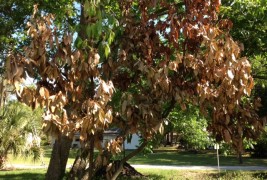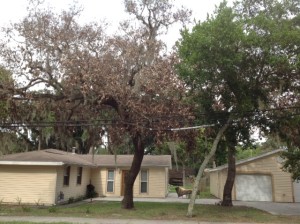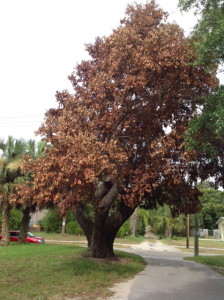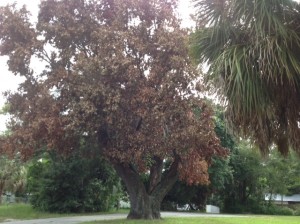Laurel Wilt, Bay Tree Deaths:
Surprising Losses in New Port Richey
Dell deChant
Chair, Environmental Committee, City of New Port Richey
Citizens of New Port Richey, Florida, in the southwest corner of the Springs Coast Watershed, may have recently noticed an unusually large number of dead and dying trees, some of which are huge, once beautiful specimens. We are talking about a lot of trees that have died or are dying now. Such a die-off is noticeable in a small community, like New Port Richey (population about 15,000).
This writer is not a certified arborist, so the presentation offered here is not a professional assessment. However, since no other reports on this rather significant local die-off have been generated (professional or otherwise), this presentation will at least call attention to the loss of important residents in New Port Richey’s urban forest, and perhaps a call for vigilance with regard to the remaining trees in the city and the Springs Coast Watershed – and, maybe, some motivation for the city sponsoring a staff member to attain certification as an Arborist.
The Trees and Their Killer
As will be explained in detail here, the likely culprit in this mass killing is a new disease to Florida (circa, 2005), laurel wilt, whose primary target is bay trees. Dead and dying trees can be seen throughout the city. No area is immune, although there seems to a particularly large concentration of dead trees in the neighborhoods of East Madison, East Grand, and West Grand – but they are everywhere.
The dying trees are members of the laurel family, which also includes camphor trees and (ominously) avocado trees. But bay trees (especially swamp bays and redbays) are the bellwether for laurel wilt. There are several bay tree species in Florida and they are difficult to tell apart:
- Gordonia lasianthus; loblolly bay
- Magnolia grandiflora; southern magnolia, bull bay
- Magnolia virginiana; sweetbay
- Persea borbonia; redbay
- Persea palustris; swamp bay
It appears the most common bays in this area of the Springs Coast Watershed are the redbay, sweetbay, and swamp bay. We’ll leave it up to professional Arborists to clarify or correct. Identification of these three as most common is based on observations over many years and discussions with others familiar with our companion flora.
In a garden I curate, we had a lovely young redbay from which we enjoyed wonderful leaves since it was a young sapling. No more. That tree is dead now, and so is an older companion not more than 100 yards away. Within three blocks of our garden are ten dead bays; most appear to be redbays, over 40 feet tall.
How The Bays Perish
As noted above, professional sources suggest that our bays are dying from laurel wilt, a quick-killing disease spread by a fungus carried by ambrosia beetles. As reported in sources, most ambrosia beetles attack weak trees and shrubs, but some varieties attack healthy trees. Notably, redbay ambrosia beetles are the subspecies that attack healthy trees – like the ones that once proliferated in New Port Richey and throughout the Springs Coast Watershed.
Observation of trees in this area reflects the impact of the pathogen as described in professional literature. Once the beetle has burrowed into the tree, it leaves a fungus in the sapwood, infecting the tree. The maturation of the fungus blocks the tree’s vascular system, eventually shutting down the circulatory system.
The process seems similar to the way citrus greening works – only faster. With the vascular system compromised, soon enough the leaves begin to wilt, and in surprisingly quick (and sad) order the entire tree is dead. This is certainly what is happening here in New Port Richey at the southwest corner of the Springs Coast Watershed.
How Ambrosia Beetles Got Here
This beetles’ original home is South and East Asia. Sources report that it had reached North America by 2002, arriving in Georgia in packing materials. The first of these tiny insects (about 2 mm in length) was found and identified in Port Wentworth, Georgia, in 2002.
Since then, Ambrosia beetles have been linked to destruction of native bays in Georgia and South Carolina. By 2005 the beetles were Florida; first in Duval County, then (by 2006) Indian River County, and by 2008 in Okeechobee and Brevard Counties. An article in the Tampa Bay Times reported them in Pinellas and Hillsborough counties in 2012.
Surely they were in the watershed by then or not long after. Still, I have not found any definitive sources indicating that the beetles and the disease they spread are here. The popular press article referenced above, reported the disease was not yet in Pasco and Hernando counties, parts of which are in the Springs Coast Watershed. Such reports may exist, and if not, this can be the first one, or at least a call for the generation of such a report. I am fairly certain the beetles and the disease they spread are here, and here in force – the dead bays tell as much.
Readers are invited to share reports and information about their experience with laurel wilt and bay trees in their area. They are also encouraged to plant trees on their properties – try oaks, hickories, and (for fruit) loquats. Be hopeful if planting redbays.
References and Resources
Map of Springs Coast Watershed (MAPS ETC)
Information about the Springs Coast Watershed (Southwest Florida Water Management District)
What is a watershed? (US Environmental Protection Agency)
A watershed is the area of land where all of the water that is under it or drains off of it goes into the same place. John Wesley Powell, scientist geographer, put it best when he said that a watershed is: “that area of land, a bounded hydrologic system, within which all living things are inextricably linked by their common water course and where, as humans settled, simple logic demanded that they become part of a community.”
“Key to Common Bay Trees of Florida,” Lynn Proenza and Michael Andreu (Univeristy of Florida, Institute of Food and Agricultural Sciences, 2013)
“Redbay Ambrosia Beetle-Laurel Wilt Pathogen: A Potential Major Problem for the Florida Avocado Industry,” Jonathan H. Crane, Jorgé Peña, and J.L. Osborne (UF, IFAS, 2013)
“Redbay (Persea borbonia): Drifting Toward Oblivion,” Kim D. Coder (Warnell School of Forestry and Natural Resources, University of Georgia, 2012)
“Redbay Ambrosia Beetle-Laurel Wilt Pathogen, geographic extent, circa 2008” Map (UF, IFAS, 2013)
“Disease-carrying beetle may kill thousands of trees in Pinellas, Hillsborough,” Mike Brassfield (Tampa Bay Times, 2012)
====================================
Side bar 1
What is a watershed? (US Environmental Protection Agency)
A watershed is the area of land where all of the water that is under it or drains off of it goes into the same place. John Wesley Powell, scientist geographer, put it best when he said that a watershed is: “that area of land, a bounded hydrologic system, within which all living things are inextricably linked by their common water course and where, as humans settled, simple logic demanded that they become part of a community.”
Side bar 2
For information about the Springs Coast Watershed see: http://www.protectingourwater.org/watersheds/map/springs_coast/





Leave a Reply